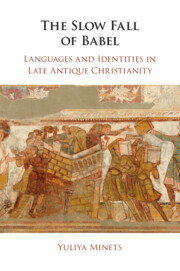19 results
Hebrew between Jews and Christians. Edited by Daniel Stein Kokin. Studia Judaica. Forschungen zur Wissenschaft des Judentums 77. Berlin: De Gruyter, 2023. vi + 357 pp. $118.99 hardcover, E-book.
-
- Journal:
- Church History / Volume 92 / Issue 4 / December 2023
- Published online by Cambridge University Press:
- 19 March 2024, pp. 986-988
- Print publication:
- December 2023
-
- Article
- Export citation
Christian Divination in Late Antiquity. By Robert Wiśniewski. Social Worlds of Late Antiquity and the Early Middle Ages. Amsterdam: Amsterdam University Press, 2020. 288 pp. €105,00 hardcover.
-
- Journal:
- Church History / Volume 91 / Issue 1 / March 2022
- Published online by Cambridge University Press:
- 23 May 2022, pp. 119-121
- Print publication:
- March 2022
-
- Article
- Export citation
Chapter 6 - The Languages of Saints and Demons
-
- Book:
- The Slow Fall of Babel
- Published online:
- 02 December 2021
- Print publication:
- 09 December 2021, pp 288-323
-
- Chapter
- Export citation
Bibliography
-
- Book:
- The Slow Fall of Babel
- Published online:
- 02 December 2021
- Print publication:
- 09 December 2021, pp 348-400
-
- Chapter
- Export citation
Chapter 2 - Languages and Identities in Greco-Roman and Jewish Antiquity
-
- Book:
- The Slow Fall of Babel
- Published online:
- 02 December 2021
- Print publication:
- 09 December 2021, pp 53-98
-
- Chapter
- Export citation
Conclusion: What’s in the Language?
-
- Book:
- The Slow Fall of Babel
- Published online:
- 02 December 2021
- Print publication:
- 09 December 2021, pp 324-347
-
- Chapter
- Export citation
Chapter 3 - The Tower of Babel and Beyond: The Primordial Linguistic Situation, the Original Language, and the Start of Linguistic Diversification
-
- Book:
- The Slow Fall of Babel
- Published online:
- 02 December 2021
- Print publication:
- 09 December 2021, pp 99-169
-
- Chapter
- Export citation
Copyright page
-
- Book:
- The Slow Fall of Babel
- Published online:
- 02 December 2021
- Print publication:
- 09 December 2021, pp iv-iv
-
- Chapter
- Export citation
Chapter 4 - Speaking in Tongues in Christian Late Antiquity
-
- Book:
- The Slow Fall of Babel
- Published online:
- 02 December 2021
- Print publication:
- 09 December 2021, pp 170-219
-
- Chapter
- Export citation
Chapter 5 - Foreign Languages and the Discourse of Otherness
-
- Book:
- The Slow Fall of Babel
- Published online:
- 02 December 2021
- Print publication:
- 09 December 2021, pp 220-287
-
- Chapter
- Export citation
Introduction: Awakening to Linguistic Otherness
-
- Book:
- The Slow Fall of Babel
- Published online:
- 02 December 2021
- Print publication:
- 09 December 2021, pp 1-17
-
- Chapter
- Export citation
Abbreviations
-
- Book:
- The Slow Fall of Babel
- Published online:
- 02 December 2021
- Print publication:
- 09 December 2021, pp viii-ix
-
- Chapter
- Export citation
Dedication
-
- Book:
- The Slow Fall of Babel
- Published online:
- 02 December 2021
- Print publication:
- 09 December 2021, pp v-vi
-
- Chapter
- Export citation
Index
-
- Book:
- The Slow Fall of Babel
- Published online:
- 02 December 2021
- Print publication:
- 09 December 2021, pp 401-418
-
- Chapter
- Export citation
Chapter 1 - Meeting the Alloglottic Other: The Socio-Linguistic Landscape of the Ancient Mediterranean and the Spread of Christianity
-
- Book:
- The Slow Fall of Babel
- Published online:
- 02 December 2021
- Print publication:
- 09 December 2021, pp 18-52
-
- Chapter
- Export citation
Contents
-
- Book:
- The Slow Fall of Babel
- Published online:
- 02 December 2021
- Print publication:
- 09 December 2021, pp vii-vii
-
- Chapter
- Export citation
Acknowledgments
-
- Book:
- The Slow Fall of Babel
- Published online:
- 02 December 2021
- Print publication:
- 09 December 2021, pp x-xvi
-
- Chapter
- Export citation

The Slow Fall of Babel
- Languages and Identities in Late Antique Christianity
-
- Published online:
- 02 December 2021
- Print publication:
- 09 December 2021
Caught in Translation: Studies on Versions of Late-Antique Christian Literature. Edited by Madalina Toca and Dan Batovici. Texts and Studies in Eastern Christianity 17. Leiden: Brill, 2020. viii + 330 pp. €169.00; $203.00 hardcover.
-
- Journal:
- Church History / Volume 90 / Issue 1 / March 2021
- Published online by Cambridge University Press:
- 01 July 2021, pp. 163-165
- Print publication:
- March 2021
-
- Article
- Export citation



